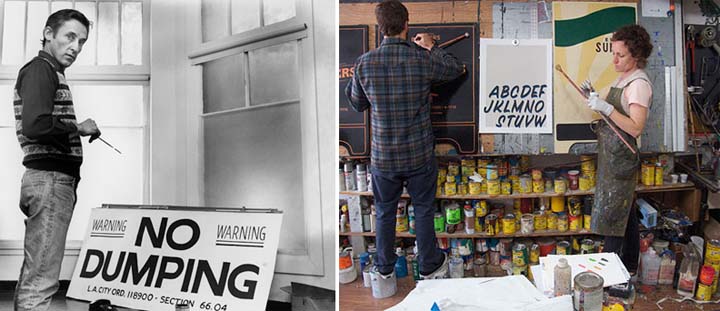The Sign Painters at TDC
In the pre-digital age storefronts, murals, banners, barn signs, billboards, and even street signs were hand-lettered with brush and paint. City neighborhoods, towns and villages had unique identities which were, in part, shaped by the painted word. But, like many skilled trades, the sign industry has been overrun by the promise of quicker and cheaper. The resulting proliferation of computer-designed, die-cut vinyl lettering and inkjet printers has ushered a numbing sameness into our visual landscape.
Fortunately, there is a growing trend to seek out traditional sign painters and a renaissance in the trade. In 2010 filmmakers Faythe Levine, coauthor of Handmade Nation, and Sam Macon began documenting these dedicated practitioners, their time-honored methods, and their appreciation for quality and craftsmanship. Sign Painters, the first anecdotal history of the craft, features stories and photographs of more than two dozen sign painters working in cities throughout the United States.

Left: Ed Rucha in his studio. Right: The New Bohemia Sign Shop in San Francisco.
In his introduction, Glenn Adamson, Head of Research at the Victoria and Albert Museum writes, “In settling on this topic, Levine and Macon are just in time. Many sign painters are now retired, or about to hang up their brushes; others have made the transition to cheaper, but depressingly homogenous vinyl letters…As is so often the case, it is at the moment of a craft’s disappearance that its cultural value suddenly becomes plain to see. It’s true that hand lettering has been appreciated by artists for decades—think of the 1930s street photographer of Walker Evans or the work of 1970s graphic designers like Paula Scher, both drawing inspiration from vernacular sources, finding in the a route out of conventional modernism. But it is only now, as we cross the digital divide, that it seems to make sense to celebrate sign painting. Handmade signage is no longer the norm, as it once was on the streets all over America. It is exceptional, in every sense of the word: the trace of a slower, less harried era.”
The book is also an oral history of an American experience from another perspective. As each of the sign painters tells his or her story, it becomes apparent that this is a breed of independent spirits. Bob Dewhurst says, “ There was a time when I could show up in a town on a Greyhound bus, sleep in a field, and be painting a sign the next day. Someone would walk over and say, ‘When You’re done, come by and do our shop.’”
Caitlin Galloway says, “When I look through books with old photographs of towns, what strikes me is the old signage. It has nothing to do with what it says or even the sign as a whole, it’s just that each O isn’t exactly the same. You rarely see that personality in a sign now.”
Josh Luke says, “Sign painting is experiencing a comeback. I’ve been a sign painter for less than ten years, but in the last two or three years I’ve noticed a much higher demand of hand-painted signs. As a newcomer to Boston, it’s great to know that the city has recently invested in beautifying its streets and storefronts. I hope that an interest in hand-painted signage will not only help the city develop aesthetically but also pay tribute to the rich architectural history and sign-making roots.”
Faythe Levine and Sam Macon will give a talk about The Sign Painters (Princeton Architectural Press 2012) at the Type Directors Club on Thursday, December 6, followed by the TDC holiday party. Tickets $20/$15/free.347 West 36th Street, Suite 603, NY, NY.


